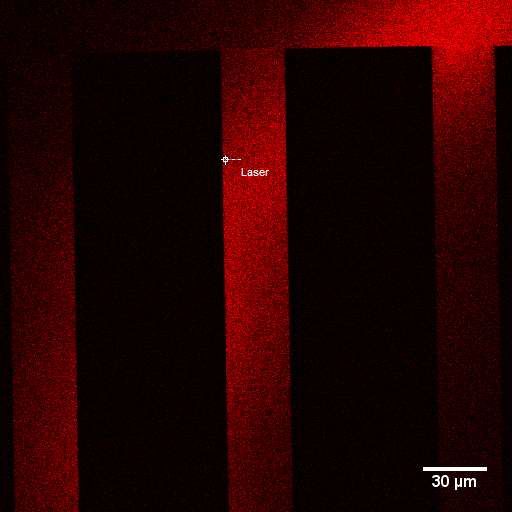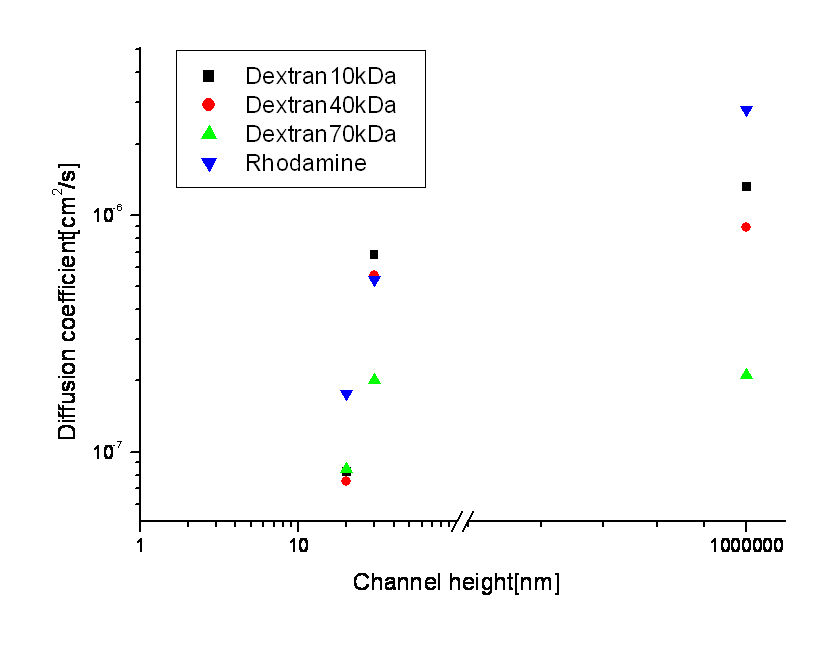385b Flurescence Correlation Spectroscopy in Nanochannels: Confined Diffusion Measurements at a Single Molecule Level
Flurescence correlation spectroscopy in nanochannels: confined diffusion measurements at a single molecule level.
Nanoscience and nanotechnology are providing fresh approaches to engineer materials with practical applications such as environmental sensors, self-assembling nanomachines, molecular-sized therapeutic, diagnostic and bioanalyitic devices and drug delivery vehicles [1]. Manufacturing micro and nanofabricated materials is of scientific and technological relevance because of the presence of voids of controllable dimensions at the atomic, molecular, and nanometer scales, thus enabling to discriminate and interact with molecules and allowing greater control over device functionality. A better comprehension of molecular transport in nanostructured media would allow optimization of many separation devices or design better release conditions for several drug delivery applications. Fluorescence correlation spectroscopy ( FCS) was used to measure molecular transport properties in constrained environment. FCS enables single molecule mobility measurement. The autocorrelation function of the intensity signal given by a fluorescent molecule which undergo Brownian motion is related to his mobility properties.
FCS together with electrical recording was carried out to study cellular membranes dynamics in correspondence to DNA threading α-hemolysin ion channels [2]. FCS measurements were also performed to probe single DNA mobility in low concentration agorose gels [3] or to detect segmental dynamics of Double-Stranded DNA as a function of DNA base pairs' number [4].
Molecular dynamics in glass nanoslits is investigated in this report and evidence of constrained diffusion are shown. Borosilicate nanochannels manufactured by chemical etching and anodic bonding procedures were used to perform FCS experiments. Channels were nanomentric in depth and micrometric in width. Depth could vary between 10 , 20 and 30 nm; whereas width was 10 or 30 microns. Channel length was 500 microns. Molecules features deeply influences transport mechanisms. Both molecular weight, molecule chemistry and deformability can affect particle mobility. Hence molecules of interest rationalize diverse possible mechanisms taking into account molecules of low and high molecular weight and flexible or globular shapes. Rhodamine dye, Dextrans and PEGs of different molecular weight and BSA were taken into account.
Nanochannels were connected by PEEK connectors to a syringe filled with nanomolar molecule solution. A small pressure was applied and the solution was sucked into the channels. The channels were first imaged in the red channel on a LEICA SP2 system with 63X water lens objective then FCS experiments were performed. Measurement time could vary between 60 and 120 seconds. Each experiment was carried out 10 times to have statistical information. Data obtained from FCS experiments were analyzed by means of an autocorrelation software which was developed in our lab, and fitted with the non-linear fitting routine on Origin Microcal 7.0. Both pure anomalous diffusion model and anomalous diffusion model upgraded for confinement were used to fit the data.
A confocal image of nanochannels of 30 nm depth, 30 microns width filled with Dextrans 10kDa is shown in picture 1. Preliminary results of molecule diffusion in nanochannels are shown in picture 2. What can be inferred from these results is that diffusion properties do change when the nanoslit dimension gets closer to molecule dimension. A general trend could be found which implies that motion deviates from bulk behavior and diffusion coefficient is lowered with the increase in confinement. Data from the higher molecular weight molecule suggest that confinement affects more low molecular weight molecules than high molecular weights probes.
Figure 1: Confocal micrograph of a nanochannel (30 nm height; 30 microns width); 63X magnification. Scale bar 30 microns. References [1] D. Rueda, N. Walter, Single Molecule Control of nanotechnology, J Nanoscience and Nanotechnology, 5, 1-11, (2005) [2] E. Chandler, A. Smith, D. Burden, Membrane surface Dynamics of DNA- threaded nanopores revealed by simultaneous single- molecole optical ensemble electrical recording. Langmuir, 20, 898-905, (2004) [3] S. Tatarkova, D.Berk, Probing single DNA mobility with Fluorescence correlation microscopy. Phisical review E 71, 041913 (2005) [4] E. P. Petrov, T. Ohrt, P. Schwille, Diffusion and segmental dynamics of double stranded DNA, Phisical reviw letters, 97, 258101, (2006) 
